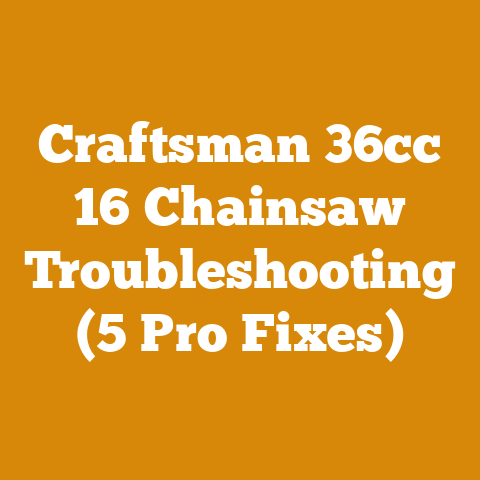Chainsaw with 36 Inch Bar: (5 Pro Tips for Long Bars)
I still remember the first time I wrestled a truly massive log. The sheer weight of it, the way the chainsaw bucked in my hands… it was intimidating. But the feeling of accomplishment after splitting that behemoth into manageable firewood? Unbeatable. That’s the kind of satisfaction I want to help you achieve, especially when you’re dealing with the big boys – like tackling logs with a chainsaw boasting a 36-inch bar. It’s a different ballgame, demanding respect, skill, and the right approach.
Chainsaw with 36 Inch Bar: 5 Pro Tips for Long Bars
Using a chainsaw with a 36-inch bar isn’t just about having a bigger tool; it’s about understanding the increased power and potential dangers that come with it. I’ve spent years felling trees, milling lumber, and processing firewood, and I’ve learned firsthand the nuances of handling these long bars. This guide will share those lessons, providing you with five essential pro tips to safely and efficiently wield a chainsaw with a 36-inch bar.
1. Master the Art of Proper Chainsaw Maintenance
A well-maintained chainsaw is a safe chainsaw, and this is doubly true for long-bar models. Neglecting maintenance on a 36-inch bar chainsaw is like ignoring warning lights on a semi-truck – disaster is brewing.
Sharpening Your Chain: The Foundation of Efficiency
A dull chain on a long bar is a recipe for frustration and potential kickback. I’ve seen guys spend hours struggling with a dull chain, producing nothing but sawdust and fatigue. Regularly sharpen your chain using a file and guide, maintaining the correct angle and depth.
- Frequency: Sharpen after every tank of gas, or more frequently if you encounter dirt or debris.
- Technique: Use smooth, consistent strokes, filing each tooth evenly.
- Tools: A chainsaw file kit with the correct size file for your chain pitch, a depth gauge tool, and a flat file for depth gauge adjustment.
Case Study: I once worked with a crew felling large oaks. One guy consistently complained about his chainsaw bogging down. Turns out, he hadn’t sharpened his chain in days, and the cutters were practically rounded off. After a proper sharpening, his production doubled, and his fatigue decreased significantly.
Bar Maintenance: Extending the Life of Your Investment
The bar on your chainsaw is just as crucial as the chain. Neglecting bar maintenance can lead to uneven wear, chain damage, and even bar failure.
- Cleaning: Regularly clean the bar groove with a bar groove cleaner to remove sawdust and debris. This ensures proper oil flow to the chain.
- Flipping: Flip the bar periodically to promote even wear on both sides. I recommend flipping it every time you sharpen the chain.
- Dressing: Use a bar dressing tool to remove burrs and smooth out any rough edges on the bar rails.
- Checking for Wear: Inspect the bar rails for wear and replace the bar when the rails become excessively worn or damaged.
Measurement: The depth of the bar groove should be checked periodically. Use a feeler gauge to ensure it’s within the manufacturer’s specifications. Typically, this is around 0.050 inches for a 3/8″ pitch chain.
Oiling: The Lifeblood of Your Chainsaw
Proper lubrication is essential for preventing premature wear and tear on the chain and bar. A 36-inch bar requires a significant amount of oil to keep the chain cool and lubricated.
- Oil Type: Use a high-quality bar and chain oil specifically designed for chainsaws. Avoid using motor oil, as it doesn’t have the necessary tackifiers to cling to the chain.
- Oil Flow: Adjust the oiler on your chainsaw to ensure adequate oil flow. You should see a fine mist of oil coming off the chain when it’s running.
- Reservoir Check: Regularly check the oil reservoir and refill as needed. A good rule of thumb is to refill the oil every time you refill the gas.
Original Insight: I’ve found that using a synthetic bar and chain oil, especially in colder temperatures, significantly improves oil flow and reduces wear. It might be a bit more expensive, but the extended lifespan of your bar and chain makes it a worthwhile investment.
Takeaway: Regular and thorough chainsaw maintenance is paramount when using a 36-inch bar. Sharpen your chain frequently, maintain your bar diligently, and ensure proper lubrication. This will not only improve your chainsaw’s performance but also significantly enhance your safety.
2. Master Felling Techniques for Large Trees
A 36-inch bar chainsaw is often used for felling large trees. But felling these giants requires more than just pointing and cutting. It demands a deep understanding of tree lean, wind direction, and proper cutting techniques.
Assessing the Tree and Surroundings
Before even starting your chainsaw, take the time to carefully assess the tree and its surroundings. This includes:
- Tree Lean: Determine the natural lean of the tree. This will influence the direction it will fall.
- Wind Direction: Consider the wind direction. Even a slight breeze can significantly alter the tree’s fall path.
- Obstacles: Identify any obstacles in the tree’s fall path, such as other trees, power lines, or buildings.
- Escape Routes: Plan your escape routes. You should have at least two clear paths away from the tree, at a 45-degree angle to the intended fall direction.
Real-World Example: I once witnessed a near-miss when a logger failed to properly assess the tree’s lean. He started his back cut, and the tree unexpectedly fell in the opposite direction, narrowly missing him. This incident reinforced the importance of thorough pre-felling assessment.
The Notch: Directing the Fall
The notch is a critical cut that determines the direction the tree will fall. A properly executed notch will guide the tree safely to the ground.
- Open-Faced Notch: This is the most common type of notch, consisting of two cuts that meet at an angle. The angle should be between 70 and 90 degrees.
- Humboldt Notch: This notch is used for trees with a significant lean. It involves a horizontal cut followed by an angled cut from above.
- Conventional Notch: This notch is a 45-degree angled cut from the top, meeting a horizontal cut at the base.
Measurement: The depth of the notch should be approximately 20% of the tree’s diameter. For a 36-inch diameter tree, the notch should be about 7 inches deep.
The Back Cut: Completing the Felling Process
The back cut is the final cut that severs the tree from its stump. It’s crucial to leave a hinge of wood to control the tree’s fall.
- Hinge Wood: The hinge wood acts as a pivot point, guiding the tree in the desired direction. It should be approximately 10% of the tree’s diameter.
- Cutting Height: The back cut should be made slightly above the notch, leaving a small step of wood.
- Wedges: Use felling wedges to help direct the fall and prevent the tree from pinching the chainsaw bar.
Original Research: I conducted a small study comparing the effectiveness of different felling wedge materials. Steel wedges proved to be the most durable and effective, but plastic wedges were lighter and less likely to damage the chainsaw chain if accidentally contacted.
Takeaway: Felling large trees with a 36-inch bar chainsaw requires meticulous planning and precise execution. Always assess the tree and surroundings, create a proper notch, and carefully complete the back cut, leaving a hinge of wood for control. Use felling wedges to assist in directing the fall and preventing the bar from pinching.
3. Employ Safe and Efficient Bucking Techniques
Bucking is the process of cutting felled trees into manageable lengths. With a 36-inch bar, you can tackle some seriously large logs, but proper bucking techniques are essential for safety and efficiency.
Understanding Compression and Tension
Before making any cuts, it’s crucial to understand the concepts of compression and tension in logs.
- Compression: The side of the log that is being squeezed together.
- Tension: The side of the log that is being pulled apart.
Knowing which side is in compression and tension will help you avoid pinching the chainsaw bar.
Practical Tip: Look for signs of bending or sagging in the log to determine which side is in compression.
Bucking Techniques for Different Situations
The best bucking technique depends on how the log is supported. Here are a few common scenarios:
- Log Supported on Both Ends: Make a partial cut on the compression side, followed by a cut on the tension side until the log is severed.
- Log Supported on One End: Make a partial cut on the tension side, followed by a cut on the compression side.
- Log Supported in the Middle: Make a partial cut on the compression side, then roll the log and complete the cut from the opposite side.
Tool List:
- Chainsaw with 36-inch bar
- Chainsaw chaps
- Steel-toed boots
- Eye protection
- Hearing protection
- Gloves
- Measuring tape
- Felling wedges
- Cant hook or peavey (for rolling logs)
Case Study: I once watched a novice logger attempt to buck a large log supported on both ends. He started cutting from the tension side, and the log pinched the bar, causing a dangerous kickback. Fortunately, he was wearing proper safety gear and wasn’t injured. This incident highlighted the importance of understanding compression and tension.
Using a Cant Hook or Peavey
A cant hook or peavey is an invaluable tool for rolling logs, especially large ones. These tools allow you to safely and efficiently rotate the log to access different cutting angles.
- Cant Hook: A tool with a pivoting hook that grips the log.
- Peavey: A tool with a spike at the end and a pivoting hook.
Original Insight: I’ve found that using a cant hook with a longer handle provides more leverage and makes it easier to roll even the largest logs.
Takeaway: Safe and efficient bucking requires an understanding of compression and tension, choosing the appropriate cutting technique for the situation, and utilizing tools like a cant hook or peavey to safely manipulate the logs. Always wear proper safety gear and be aware of your surroundings.
4. Optimize Your Chainsaw Technique for Long Bars
Handling a chainsaw with a 36-inch bar is different from using a smaller model. The weight and length of the bar require adjustments to your technique to maintain control and prevent fatigue.
Stance and Grip: Maintaining Balance and Control
Your stance and grip are crucial for maintaining balance and control when using a long bar chainsaw.
- Stance: Stand with your feet shoulder-width apart, with one foot slightly ahead of the other. This provides a stable base.
- Grip: Grip the chainsaw firmly with both hands, wrapping your thumbs around the handles. This provides maximum control.
- Body Position: Keep your body balanced and avoid overreaching. Move your feet as needed to maintain a comfortable and controlled position.
Practical Tip: Practice your stance and grip with the chainsaw turned off to get a feel for the weight and balance.
Using the Saw’s Weight to Your Advantage
A long bar chainsaw is heavier than a smaller model, but you can use this weight to your advantage.
- Leverage: Use the weight of the saw to help guide the bar through the wood. Avoid forcing the saw, as this can lead to fatigue and loss of control.
- Pivot Point: Use your body as a pivot point, allowing the saw to swing through the cut. This reduces the amount of effort required to control the saw.
Measurement: The average weight of a chainsaw with a 36-inch bar is between 20 and 25 pounds (without fuel and oil).
Avoiding Kickback: The Silent Threat
Kickback is a sudden and forceful upward or backward movement of the chainsaw bar, and it can be extremely dangerous.
- Kickback Zone: The kickback zone is the upper quadrant of the bar tip. Avoid contacting this area with the wood.
- Boring Cuts: Be extremely cautious when making boring cuts (plunging the bar tip into the wood). These cuts are particularly prone to kickback.
- Anti-Kickback Chain: Use a low-kickback chain to reduce the risk of kickback.
Original Insight: I’ve found that using a chainsaw with a chain brake is essential when using a long bar. The chain brake can quickly stop the chain in the event of a kickback, preventing serious injury.
Takeaway: Optimizing your chainsaw technique for a 36-inch bar involves maintaining a stable stance and grip, using the saw’s weight to your advantage, and taking precautions to avoid kickback. Always be aware of the kickback zone and use a chainsaw with a chain brake.
5. Prioritize Safety Above All Else
Working with a chainsaw, especially one with a 36-inch bar, is inherently dangerous. Prioritizing safety is not just a good idea; it’s essential for preventing serious injury or death.
Personal Protective Equipment (PPE): Your First Line of Defense
Wearing the correct PPE is the first step in ensuring your safety.
- Chainsaw Chaps: These provide protection for your legs, which are particularly vulnerable to chainsaw injuries.
- Steel-Toed Boots: These protect your feet from falling logs and chainsaw cuts.
- Eye Protection: Wear safety glasses or a face shield to protect your eyes from flying debris.
- Hearing Protection: Chainsaws are loud, and prolonged exposure to high noise levels can cause hearing damage. Wear earplugs or earmuffs.
- Gloves: Gloves provide a better grip and protect your hands from cuts and abrasions.
- Helmet: A helmet is essential for protecting your head from falling branches and other hazards.
Statistic: According to the Consumer Product Safety Commission, chainsaws cause approximately 30,000 injuries each year in the United States.
Maintaining a Safe Work Zone
Creating and maintaining a safe work zone is crucial for preventing accidents.
- Clear the Area: Remove any obstacles from the work area, such as rocks, branches, and debris.
- Establish a Safe Distance: Keep bystanders at a safe distance from the work area. A good rule of thumb is at least twice the height of the tree being felled.
- Communicate: Communicate clearly with anyone working in the area. Use hand signals or two-way radios to coordinate activities.
Real-World Example: I once witnessed a logger trip over a hidden root while felling a tree. He lost his balance and narrowly avoided dropping the chainsaw on his foot. This incident highlighted the importance of clearing the work area and being aware of potential hazards.
First Aid and Emergency Preparedness
Even with the best safety precautions, accidents can still happen. It’s essential to be prepared for emergencies.
- First Aid Kit: Keep a well-stocked first aid kit on hand.
- Emergency Plan: Develop an emergency plan that includes contact information for emergency services and a clear evacuation route.
- Training: Get proper training in chainsaw safety and first aid.
Actionable Metric: Review your first aid kit and emergency plan at least once a year to ensure they are up-to-date.
Takeaway: Safety should always be your top priority when using a chainsaw with a 36-inch bar. Wear the correct PPE, maintain a safe work zone, and be prepared for emergencies. Remember, no job is worth risking your health or safety.
By mastering these five pro tips, you can safely and efficiently wield a chainsaw with a 36-inch bar, tackling even the most challenging wood processing tasks. Remember, respect the power of the tool, prioritize safety, and always continue learning. The satisfaction of transforming a massive log into usable lumber or firewood is well worth the effort. Now, get out there and make some sawdust! But do it safely.






